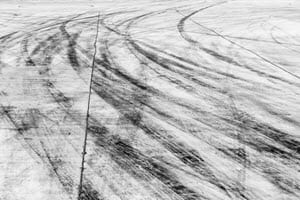Winter Car Accidents From Sleet and Snow – What Do We Know?
December 20, 2016

Ice and Snow and Winter Car Crashes
Given the size of Pennsylvania, our winter weather varies greatly by location. In the west, towards Pittsburgh, we get a lot of snow. In the east, towards Philadelphia, we get a lot of ice and sleet. No matter the type of weather you experience, driving this time of year can be quite dangerous. Bad road conditions can lead to serious and even deadly winter car accidents.
The Data for Winter Auto Accidents in Pennsylvania
Every year, the Pennsylvania Department of Transportation (PennDot) provides information about car crashes and their causes. This includes information about the number of accidents during winter weather conditions. In 2015, the most recent year for which we have data, this is what we know:
There were a total of 127,127 car accidents in Pennsylvania in 2015. Of those crashes, 1200 were fatal.
- 8,560 crashes were due to snow or slush
- 6,308 accidents were due to ice or ice patches
What does this information tell us? It tells us that there are fewer car crashes in the winter than we might have expected. Why? Probably because people tend to stay home, or at least drive more carefully in the winter. Which brings us to the next issue. If you do need to go out, how can you avoid a winter car accident?
Avoiding Car Crashes in the Winter
The first way to avoid a winter auto accident is to stay off the roads, if that is at all possible. Of course, sometimes we have no choice and have to be out and about. If this is the case for you, there are some steps you can take to decrease your chances of a crash.
Preventative Maintenance

A faulty defroster can make it impossible to see, leading to car accidents.
The place to begin is with basic car maintenance. Here in Pennsylvania, winter isn’t in full swing yet, so you still have time to take these steps. No matter the time of year, it is never too late to take care of your car.
- Make sure your wipers work properly. Windshield wipers that cause streaks can make it difficult to see and increase your chance of a crash. If your wipers streak, consider replacing them. Perhaps even with winter blades. The blades themselves are not very expensive. They range from around $10 to around $30. Installation, including blades, can cost anywhere from $70 to just over $200.
- Make sure your fluids are topped off.
- You might want to keep an extra bottle of wiper fluid in your car. You don’t want to run out when slushy dirt is sticking to your windshield in the middle of a storm.
- If you have never topped off your windshield wiper fluid, this is the time to find out how. In most cases, the tank is easily accessible and clearly labeled.
- Check your heater and defroster to make sure they are working. If your defroster isn’t working, it can make it difficult if not impossible to see. If your heater isn’t working and you get stuck somewhere, you could find yourself in a dangerous situation.
- Unfortunately, replacing a heater isn’t as cheap as replacing windshield wiper blades. The price ranges from $300 to $1000, depending on the car and where you live. But if you catch problems early on, perhaps you will have a repair bill instead of an expensive replacement bill. The problem might be simple and inexpensive, such as a clamp, for example. Proper maintenance can prevent problems and will save you a lot of money. This is one reason that checking fluids matters.
- Make sure your tires are in good condition and have the correct amount of air.
- At a minimum, you should have all weather tires on your car. Make sure they are rated for both mud and snow.
- If you live in an area with heavy snow, you might want to consider having your regular tires replaced with snow tires this time of year. Otherwise, you might want to carry a set of chains in your trunk. Be sure to check Pennsylvania laws on using chains.
- Make sure your brakes work. Have a mechanic check your brakes and make sure that they are in proper, working condition and that it is not time for them to be replaced. If you wait for an emergency, you won’t be able to look for good deals. Look early on and you can shop around.
- Most newer cars have anti-lock brakes. If you find yourself in trouble, don’t pump anti-lock brakes. Instead, press down hard and steady. Consider practicing ahead of time so you know how your brakes feel. If your anti-lock brakes have never kicked in, you might be surprised at the vibration and let up. This is the exact opposite of what you want to do.
- If your car does not have anti-lock brakes, you want to use a pressing and pumping motion. Pressing too hard can cause your brakes to lock up, which is why you want to pump the brakes.
- Check all hoses and belts. You don’t want something to break when you are out on the road. You also don’t want your car come to a sudden stop in the middle of the road, where you are likely to be hit.
- Make sure your lights work. It is critical that people be able to see you. Working lights help to make sure they can.
- Use your lights. Even if you can see, it doesn’t mean other people can see you.
- Check your battery. During the cold weather, batteries lose a lot of their charge.
- Carry a kit in your car. This won’t help prevent accidents, but if you do get stuck, it could save your life.
Avoiding a Crash

Knowing how to respond to a skid is a critical part of winter driving.
If you think you are going to have an accident there are a number of ways you can respond to avoid the crash or at least to minimize the damage.
- The most common issue you might run into on a icy or snowy road is a skid. The best way to avoid a skid in the first place is to slow down, but if you find yourself in one, AARP suggests these actions:
- Try not to panic. If you do, it will be hard to settle down and remember how to respond.
- Don’t brake. Hard to believe this is the proper response, but putting your foot on the brake can make things worse. Get your foot off the accelerator too.
- Steer the way you want to go. Look in that direction too. Your hands tend to follow your eyes.
- It is easy to oversteer due to the adrenaline you will be feeling, so you will probably need to correct your steering into the other direction once your car starts responding. Don’t make sharp turns. Don’t overcorrect. Be as calm and as smooth as possible.
- Once you regain control, take a couple of deep breaths and keep on your way.
- It is easy for other drivers to lose control and hit you, especially when you are stopped. Here is how to decrease the risk of a rear end collision:
- Watch ahead for stopping cars and give yourself plenty of time to slow and stop. If you stop short, you increase your own chances of skidding. You also increase the chances of other drivers not having enough time to stop in time to avoid hitting you.
- Be aware of escape routes. Give yourself space. This way you can move up if someone is about to hit you. Keep an eye out for a chance to move out of the way of a car that is about to hit you. Keep in mind though, if a sidewalk is your option, that it is critical to be aware of and avoid pedestrians.
- Don’t follow other cars too closely. When you do, if they have to slam on their brakes, you will have to slam on yours, increasing the risk of being hit from behind. And of course, you are increasing your own chance of hitting the car in front or skidding. Give yourself more space than normal on bad weather days.
- Don’t brake check other cars. It is tempting to tell people to back off this way, especially when the roads are bad, but it is also a great way to get rear ended. If someone is driving dangerously behind you, find a way to let them pass. Pull into a gas station or store parking lot if you need to. It is better to let dangerous drivers have the road, especially when the conditions are bad.
Final Thoughts about Winter Accidents
Winter is a dangerous time to drive and serious accidents happen. The best way to avoid someone else hitting your car is to be aware of what is going on around you. Give yourself space and escape routes, so you can move out of the way of any out of control cars or unsafe drivers. The best way to avoid causing an accident is to keep your car well maintained, drive properly for the conditions, focus on the road and drive defensively.
If you are in a car crash this winter due to someone else’s negligence, please reach out to Lowenthal & Abrams. We are here to protect your rights all year long.
 Free Consultation
(610) 667-7511
Free Consultation
(610) 667-7511
 Free Consultation
(610) 667-7511
Free Consultation
(610) 667-7511



